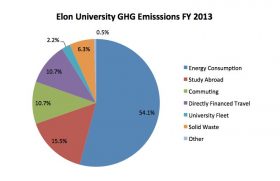Per student and per square foot, the university's greenhouse gas emissions continue to decrease from initial data collected for Elon's first such inventory in 2008.
 Elon University’s greenhouse gas emissions have increased over the past six years with the growth of both the campus population and its number of facilites, but on a per student and per square foot measurement, emissions levels continue their steady decline, according to the sixth annual Greenhouse Gas Emissions Inventory released this month by sustainability leaders at the university.
Elon University’s greenhouse gas emissions have increased over the past six years with the growth of both the campus population and its number of facilites, but on a per student and per square foot measurement, emissions levels continue their steady decline, according to the sixth annual Greenhouse Gas Emissions Inventory released this month by sustainability leaders at the university.
Between fiscal year 2008 and 2013, Elon’s square footage increased 22 percent, yet emissions per 1,000 square feet decreased 16.4 percent. During this same period, the number of full-time equivalent students increased 10.5 percent even as emissions per student decreased 7.6 percent.
“Conducting a yearly emissions inventory is essential to monitor progress toward Elon’s goal of carbon neutrality set forth in the Sustainability Master Plan,” said Elaine Durr, the university’s director of sustainability.
 To achieve carbon neutrality, Elon must measure and take steps to reduce greenhouse gas emissions, Durr said. Beginning in 2008, a greenhouse gas emissions inventory has been conducted annually, and a Climate Action Plan was completed in 2010. That plan serves as a roadmap for carrying out projects designed to reduce greenhouse gas emissions and is a dynamic document that will be revised as technology, research and incentives develop.
To achieve carbon neutrality, Elon must measure and take steps to reduce greenhouse gas emissions, Durr said. Beginning in 2008, a greenhouse gas emissions inventory has been conducted annually, and a Climate Action Plan was completed in 2010. That plan serves as a roadmap for carrying out projects designed to reduce greenhouse gas emissions and is a dynamic document that will be revised as technology, research and incentives develop.
Total greenhouse gas emissions were 2.1 percent higher in the most recent inventory in large part due to an increase in directly financed travel, which includes faculty and staff business travel as well as athletic team travel.
The increase could be the result of improved data collection and/or more actual travel, Durr said. Directly financed travel falls under the category of transportation along with study abroad travel, commuter travel and fuel use in the university fleet. Commuter travel accounts for 10.7 percent of Elon’s most recent fiscal year emissions, which is determined with data from a commuter habit survey.
 Transportation is the second largest source of Elon’s greenhouse gas emissions, accounting for 36.9 percent of total emissions. Energy consumption is the largest source of emissions, accounting for 54.1 percent.
Transportation is the second largest source of Elon’s greenhouse gas emissions, accounting for 36.9 percent of total emissions. Energy consumption is the largest source of emissions, accounting for 54.1 percent.
“This most recent greenhouse gas emissions inventory indicates a positive effort toward the goal of carbon neutrality as identified in the Sustainability Master Plan,” Durr said.
The Office of Sustainability completed the greenhouse gas emissions inventory with the assistance of a student intern. The process involved collecting data from numerous departments, ranging from the Physical Plant for electricity and natural gas consumption to Human Resources for the number of employees. Many departments and individuals on campus contributed information needed to complete the inventory.
To learn more about the Greenhouse Gas Emissions Inventory, Climate Action Plan or commuter habit survey please visit the Climate page of the Sustainability website. To learn more about the greenhouse gas emissions summer internship opportunity, email sustainability@elon.edu.


